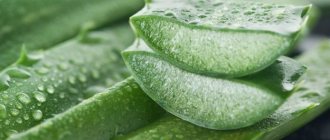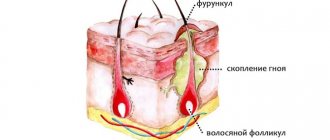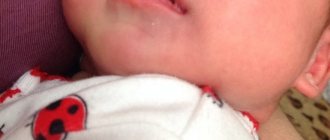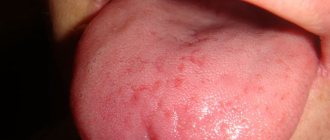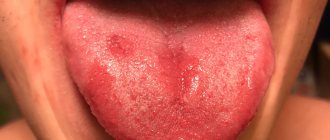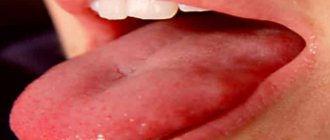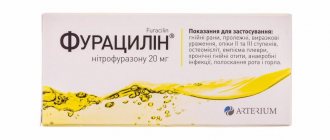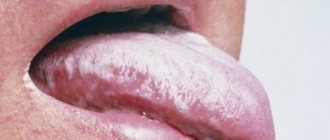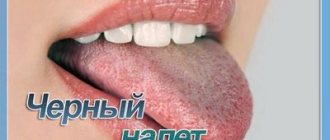A lump on the inside of the lip is a seal that not only causes aesthetic discomfort, but also signals the presence of some disease that caused its appearance.
Therefore, regardless of the etiology, it should be immediately disposed of as soon as possible. This article provides information about the main reasons for its appearance and methods of treating such a neoplasm.
Why can a lump appear on the lip?
Lumps on the lips indicate pathological conditions in the body. They appear in diseases and injuries of various origins.
If a lump appears on your lip, the reason may be as follows:
- injury to the lip and oral cavity;
- dental infections;
- viral diseases of various body systems;
- bacterial and fungal inflammatory diseases;
- tumor and cystic neoplasms.
These causes can be divided into pathological, caused by diseases, and normal, caused by other factors.
An example of the appearance of a labial growth in the photo.
Possible diseases
If a seal appears on the lip, it may be caused by the following diseases:
| Disease | Symptoms |
| Respiratory tract infections | With viral and bacterial diseases of the respiratory tract, small red and flesh-colored balls may appear on the outer surface of the mouth. They appear due to decreased immunity, and after recovery they disappear on their own. |
| Stomatitis | Stomatitis is an inflammatory disease of the mucous membranes of the mouth, most often found in children. Depending on the cause of the inflammation, the bump on the inside of the lip may be clear, red, white, blue or dark brown. |
| Candidiasis | With candidiasis, small white bumps form in the oral cavity, painless on palpation. They can be localized on the inside of the lips, gums or tongue. |
| Herpes | When infected with the herpes virus, a round, painful lump forms on the inside of a person’s lips, which is a blister with clear liquid inside. The inflamed area is itchy and may become covered with a purulent crust. |
| Human papillomavirus | A warty, white or flesh-colored growth occurs when infected with HPV. In the early stages of the disease, the tubercle appears in a single copy, after which their number increases, and the edges of the growths merge with each other. |
| Syphilis | A person infected with syphilis develops a chancre near the lip: a small hard ball resembling a subcutaneous pimple. Chancre signals the onset of the disease and disappears when syphilis enters stage 2. |
| Leukoplakia | With leukoplakia, keratinization and thickening of the epithelium on the oral mucosa occurs. Small white growths form inside the lip, on the tongue and gums. If left untreated, they develop into cancer. |
| Lip cancer | When a malignant tumor occurs, a large red or black lump appears on the oral mucosa. It can be localized on the lip, gums or throat. The lump hurts when touched and may bleed. |
Other factors
Other factors that can cause a lump on the lip include:
- Lip injuries
. A retention blood cyst occurs in wounds: when biting, after a cut or after a blow, when wounded by dental instruments during examination and treatment by a doctor. - Burn when eating hot food
. Hot food or drinks cause thermal damage to the lip tissue. Like mechanical injuries, it causes lumps to appear. - Insect bites
. Blisters caused by an insect bite in the mouth area can take a hard form and turn into a lump. - Malocclusion.
The abnormal position of the teeth causes permanent injury to the lips on the inside, leading to the formation of a pineal growth. - Orthodontic problems
. Incorrect installation of braces or dentures, as well as the retention period of orthodontic treatment, can cause mechanical injury to the lip. - Chemical burn.
When taking certain medications and consuming alkali, a burn may occur in the mouth, leading to the appearance of a lump. - Allergic reactions.
Upon contact with an allergen, the patient may experience small white growths in the oral cavity, including on the lips. - Punctures, wearing piercings.
Trauma and constant friction against the lip tissue causes cystic neoplasms with blood located next to the irritant. - Bad habits.
Smoking and drinking alcohol can cause chronic burns. Like a simple thermal burn, it provokes the appearance of neoplasms.
In case of bite pathologies, incorrect installation of braces and dentures, you should consult a specialist: a dentist or orthodontist.
The remaining reasons listed in the list do not require medical intervention.
How to deal with bloody pimples inside the mouth?
While blood in a blister in your mouth will usually disappear spontaneously, there are things you can do to speed up the process. Here are some tips:
Typically, getting rid of blood blisters entails using home remedies or treating the underlying cause. Home remedies are more common, especially if the cause is known and is an allergy or injury.
Home Remedies for Bloody Pimples
There are some home remedies that you can try to get rid of blood blisters in your mouth.
- One is to use ice. Placing ice on a bloody pimple or sucking pieces of ice close to the pimple area will compress the blood bubbles, which will stop the bleeding.
- Tea tree oil is an astringent that will reduce pain and dry out blisters, reducing inflammation in the process. Can heal blood blisters because it has anti-inflammatory properties that will also cool the area where it appears and help relieve pain. To use it, you should dilute the oil with water in the proportions of 1 : 1 and rinse your mouth with it.
- Sandalwood powder can be mixed with rose water to make a paste that can be applied to the blood blister. It absorbs heat from the blister so that healing occurs faster. It also helps with inflammation and pain.
- You can also use turmeric paste mixed with rose water or honey. It is an antiseptic and can prevent you from getting an infection.
Oral hygiene
You should not use a toothbrush when you have blisters in your mouth as this can only cause more damage to the tissue. Even a soft toothbrush can irritate the lining of your cheek. Instead of using a toothbrush, gently use your fingers to clean your teeth by resuming use toothbrush when everything has healed.
As tempting as it may be, do not squeeze or attempt to pop a blood pimple or blister on any area inside the mouth, as this will prolong the pimple's healing time, possibly leading to scarring or further infection. Instead, you should aim to suppress swelling and minimize discomfort you feel You can try the following remedies to treat blood pimples:
An effective natural remedy for Peppermint that quickly kills any acne!
- When this is not the first time you notice a blood lump in any area of the oral cavity, you definitely need the help of a doctor, which you should seek immediately.
- Rinse your mouth regularly with an antibacterial mouthwash or water mixed with a teaspoon or two of sea salt or table salt.
- Be careful when you brush your teeth.
- Avoid any salty or strong foods that irritate the affected areas of the mouth, such as salty chips, nuts or pickles, as well as chocolate and other sweets, as these can irritate the sores, worsening the pain and prolonging your blood pimple healing symptoms.
- You should also avoid acidic fruits and vegetables, including oranges, lemons, grapefruits and tomatoes.
- Avoid eating raw vegetables, as they are too strong and may further injure sore areas in your mouth; instead, consume soft foods that are easier to chew and swallow.
- Consumption of hot foods should also be strictly limited during this period, so wait until your food and drinks have cooled to room temperature before eating them.
Most blood pimples and blisters clear up on their own in about a week, although larger pimples may take longer. If you have persistent pain, or if your symptoms recur, you may need to see a doctor to get checked.
Which doctor should I contact?
Depending on the cause of the pathology, consultation with the following specialists may be required:
- Dentist: bite pathology, trauma after examination.
- Orthodontist: incorrectly selected and installed braces, dentures.
- Allergist: severe allergic reactions.
- Oncologist: malignant neoplasms on the lip.
- Oral and maxillofacial surgeon: the need to remove a cyst or tumor.
If the lump comes out due to fungal, bacterial or viral infections, treatment will be carried out by a general practitioner, pediatrician or family doctor.
Wart removal in the clinic
The clinic uses modern hardware techniques to excise growths:
- Laser therapy . The method allows you to quickly and without blood remove the growth. There is no discomfort during the procedure, as pain relief is performed. During one session, you can get rid of several tumors in a very short time. The method is suitable not only for adults, but also for children. The likelihood of relapse is minimized. Skin defects in the form of scars after laser use are very rare.
- Radio wave therapy . The technique is considered the safest. When excising a wart using a radio wave, there is no contact with the skin. It is not always possible to completely remove the growth. The procedure leaves no traces of impact.
- Electrocoagulation . The procedure requires anesthesia. Using an electrode to which a high-frequency electric current is applied, the wart is burned out, followed by cutting off the growth with a special metal loop. Scarring may appear after removal.
- Cryodestruction . Liquid nitrogen is used and the wart is treated until it turns white. As a result of exposure to low temperatures, the growth tissues die. There is no need for anesthesia for the manipulation. The disadvantage of the technique is the lack of control over the depth of nitrogen exposure. For this reason, frequent relapses occur.
- Surgical. Removal is done using a scalpel. The disadvantage of the procedure is the formation of a scar, so this technique is used only for certain indications (in case of malignancy of the process and large size of the wart).
Diagnostics
You can determine why a lump appears on your lip using diagnostic procedures:
- Inspection and palpation of the growth on the lip, detailed questioning of the patient, study of the anamnesis.
- Taking general and biochemical blood and urine tests.
- Hardware studies: ultrasound, x-ray, probing of gland ducts, sialography.
Instrumental diagnostics are used for neoplasms on the lip: cysts, tumors.
Pharmacy products for removing warts
You can buy medications at the pharmacy that will help you deal with warts at home.
Among them:
- Super clean . The product is an alkaline solution that has a chemical effect on the growth, causing cauterization.
- Cryopharma, Wartner . These agents cause cryodestruction of the wart; as a result of cold exposure, the neoplasm is frozen.
- Solcoderm . A drug containing acids that have a cauterizing and mummifying effect on pathological tissues.
- Immunomodulators – Viferon, Oxolinic ointment will help increase immunity and the body’s fight against the virus.
- Antiviral agents – Isoprinosine, Interferon.
The use of cauterizing agents on the lips and face is extremely undesirable; application of these agents to the oral mucosa is especially dangerous.
Are bumps on the lips dangerous?
The danger of bumps on the lips depends on the cause of their occurrence. Small blisters that appear after eating hot food or an insect bite will not harm the body.
Complications can result from:
- retention cyst caused by trauma;
- inflammation due to infections;
- herpes and papilloma on the lip.
Important!
New growths that appear due to smoking or drinking alcohol are also dangerous. If you don't change your lifestyle and give up bad habits, they can develop into lip cancer. A lump on the lip is a neoplasm caused by injury or disease. To prevent the pathology from developing into cancer and causing further complications, consult a specialist.
Treatment methods
In addition to observation, modern medicine offers two ways to treat a lump inside the lip: conservative and radical.
Conservative traditional therapy includes:
- Immunotherapy. Prescription of immunomodulators and immunoregulators.
- Antiviral therapy. Suppression of virus replication and inhibition of the stages of virus-cell interaction.
- Physiotherapy. UV treatment, oxygen therapy, dosed hypothermia.
- Drug therapy. Irrigation, creams, ointments, vitamins.
- Antibiotics. A sensitivity test is required.
- Traditional medicine. Medicinal plants (Kalanchoe, aloe, chamomile, etc.) in the form of decoctions, solutions, lotions.
- Vaccination. Lesions of a viral nature are easier to prevent with vaccine therapy.
Cystectomy of a retention cyst is performed by a dentist using a surgical scalpel, laser, ultrasound or radiofrequency devices.
Cases in which treatment of a lump on the lip from the outside involves surgery:
- Cyst recurrence. The cyst must be removed completely (the shell along with the contents). Otherwise she might jump up again.
- Very active tumor growth. Untimely treatment aggravates the pathological process and the tumor tends to spread to neighboring tissues.
- Induration of the cyst. Stagnation creates favorable conditions for the degeneration of a cyst into scar tissue (fibroadenoma).
Diseases with different etiologies require a wide range of treatment methods:
- Laser therapy is a modern, fast treatment and recovery. It is performed under local anesthesia for up to 1 hour. This treatment is safer with fewer side effects.
- Cryotherapy is used in cases where other methods are powerless. The cone is frozen with liquid nitrogen and removed.
- Corticosteroid injections help relieve symptoms of inflamed mucous membranes.
- Homeopathy can cure cysts, papilloma and hemangioma with drugs such as Arnica, Psorinum.
- Drug treatment consists of taking antibiotics of the penicillin group (Tetracycline), anti-inflammatory (Diclofenac), painkillers, immunostimulating agents (Echinacea, Eleutherococcus), and includes rinsing the mouth with antiseptic agents.
- Surgical operations are most often prescribed for malignant neoplasms and to remove cysts. The operation is performed under local anesthesia.
- Hirudotherapy – leeches are used to dissolve benign lumps.
- Traditional methods: decoctions, lotions, infusions. They are used as a concomitant treatment with the main treatment.
